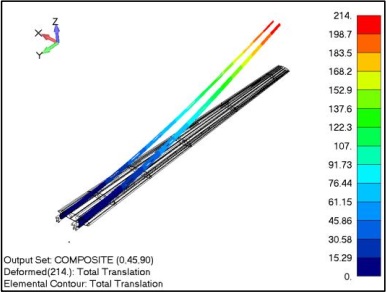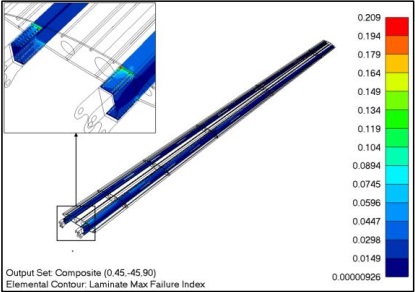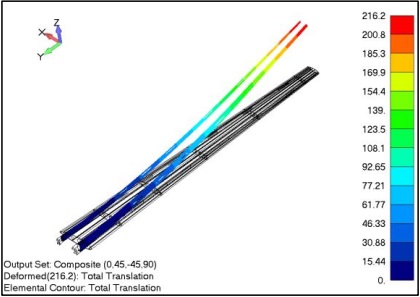This section presents the results of the finite element analysis. It examines the structural integrity of the spars when constructed from various materials and evaluates their performance against different failure criteria. Additionally, it compares the overall deformation of spars made from aluminium with those constructed from composite materials to assess their relative stiffness. Furthermore, it compares weight optimization results for various combinations of ply orientation and thickness.
In this section, the findings from FE model 1 are presented, which consists of aluminum components and serves as the reference model. The model has been precisely manufactured and is currently in operational use. The safety factor for the Von Mises stress is 1.5, resulting in an allowable stress of 385/1.5 = 256 MPa. The maximum occurring stress is below this level. The following figures show the FEM results of model 1. Figure 5 shows the Von Mises stresses in the wing. The stresses are higher near the root area due to the maximum bending moment, while they are lower near the tip where the bending moment decreases. The maximum occurring stresses are below the allowable criteria.
Figure 6 illustrates the Von Mises stresses in the wing spars. The maximum stresses are observed near the wing root. Since the front spars are stiffer than the back ones, they experience higher stress. However, it is important to note that the highest stress in the wing spars is lower than the allowable limit. In Figure 7, the total deformation of the wing is shown to be 213mm. This deformation is considered a reference for the composite spars. It is worth noting that the deformation near the root is minimal because the wing has more stiffness near the root area. The highest deflection occurs at the wing tip due to the flexibility of the tip.
Figure 8 shows the displacement of the wing along the length of the wing. The graph illustrates the variation in deformation from the root to the tip of the wing. The deformation is not linear along the wing span because the stiffness of the wing varies along the length of the wing.
In this section, we present the findings from Finite Element (FE) Model 2, which incorporates spars made of composite materials with a layup sequence of [0/30/60/90] s degrees. Different thicknesses are assigned to different regions, for continuous distribution of material for front and back spars. The regions are highlighted in Figure 2.
Table 6 shows the material distribution for the back spar.
FEM model 2 exhibits an equivalent stiffness to FEM model 1. The maximum laminate failure index, at 0.199, demonstrates that with this specific arrangement and quantity of plies, the structural integrity of the spars is deemed satisfactory. Figure 9 shows the results of the maximum laminate failure index for FE model 2. The high index occurs near the root area. The index shows that spars with this sequence are strong enough to withstand the loads.
Figure 10 shows the deformations of spars in the FE model 2. The deformation at the wing tip corresponds to the deformation of metallic spars in the FE model 1. The wing stiffness behavior of the composite spars matches the results of metallic spars.
In this portion, we present the results obtained from Finite Element (FE) Model 3, which integrates spars constructed from composite materials following a layup sequence of [0/45/90] degrees. The material distribution for the front spar in FE model 2 is given in table 7.
The Table 8 shows the material distribution for the back spar.
Figure 11 and Figure 12 show the results for Model 3. FEM model 3 demonstrates a stiffness comparable to that of FEM model 1. The maximum laminate failure index, at 0.216, indicates that with this particular arrangement and number of plies, the structural integrity of the spars is considered satisfactory.
Figure 12 illustrates deformations of spars in the FE model 3. The deformation at the wing tip corresponds to the metallic spars in the FE model 1. The wing stiffness behavior of the composite spars is consistent with the results of metallic spars.
In this section, we present results from Finite Element Model 4, which utilizes composite material spars with a [0/45/-45/90] layup sequence. The material distribution for the front spar in FE model 3 is given in Table 9.
Table 10 shows the material distribution for the back spar.
Figure 13 and Figure 14 show the FEM results for the model 4. The laminate failure index reaches a maximum value of 0.209, signifying that, given the specific configuration and ply count, the structural integrity of the spars is acceptable.
Figure 14 shows deformations of spars in the FE model 4. The deformation at the wing tip corresponds to the metallic spars in the FE model 1. The wing stiffness behavior of the composite spars is consistent with the results of metallic spars.
Figure 15 shows the deformations of the spars along the wing span in all FE models. The deformation of metallic spars and composite spars with different stacking sequences shows consistent behavior under the same loading. This illustrates that integrating composite material with specified stacking sequences will not change the stiffness of the behavior of the wing.
This section discusses the finite element analysis results, focusing on structural integrity and performance for spars made of different materials. Deformations, failure criteria, and relative stiffness are explored for aluminum and composite spars with different layup sequences across various FE models. Considering FE MODEL 1 (Aluminum Components), the aluminum model acts as a benchmark, showing real structural design with stresses distributed along the wing. Total wing deformation serves as a baseline for comparisons with subsequent composite spar models. FE MODEL 2 (Composite spars – sequence 1) introduces composite spars with a [0/30/60/90] layup sequence, showing equivalent stiffness to Model 1. The maximum laminate failure index confirms structural integrity, and deformation aligns consistently with metallic spars.
FE MODEL 3 (Composite spars – sequence 2), with a [0/45/90] layup sequence, shows comparable stiffness to Model 1. The maximum laminate failure index falls within limits, and deformation aligns consistently with metallic spars. FE MODEL 4 (Composite spars – sequence 3), using a [0/45/-45/90] layup sequence, shows equivalent stiffness to Model 1. Maximum laminate failure index and deformation analysis reinforce consistent behavior with metallic spars. The detailed overview shown in Figure 15 gives the comparison of deflections of the wing in all FE models. This study aimed to integrate composite materials without changing the stiffness. This is achieved by tailoring the thicknesses of the laminates of different stacking sequences. This iterative process is performed through computer science algorithms particularly Finite Element Analysis (FEA). This allows for a detailed examination of the strength and performance of UAV wing spars.
Computer-based algorithmic optimization plays a key role in finding optimal results by varying thicknesses and orientations of different plies of composite materials. This approach aims to achieve the best combinations meeting stiffness and strength criteria with reduced weight. The data science techniques made it possible to manage and analyze the data, providing important insights into how composite materials performance compared to traditional metal components.
Computer-aided design (CAD) systems coupled with FEM expedite the design process, leading to an efficient and iterative optimization process. The summarized results demonstrate that high strength and flexibility in UAV wings are attainable using composite materials. The well-optimized solution with reduced weight is a testament to the advanced FEM technique, with visual representations aiding in understanding the complex problem and achieving desired outcomes.
[1] C. Soutis, “Aerospace engineering requirements in building with composites,” Polym. Compos. Aerosp. Ind., pp. 3–22, Jan. 2020, doi: 10.1016/B978-0-08-102679-3.00001-0.
[2] V. R. A. Prakash, M. Bourchak, H. Alshahrani, and K. A. Juhany, “Synthesis and characterization of lightweight unmanned aerial vehicle composite building material for defense application,” Biomass Convers. Biorefinery, pp. 1–12, Aug. 2023, doi: 10.1007/S13399-023-04736-2/METRICS.
[3] N. Mazlan, T. Chai Hua, S. M. Sapuan, and R. A. Ilyas, “Evolution of Aerospace Composite Materials,” Adv. Compos. Aerosp. Eng. Appl., pp. 367–385, Jan. 2022, doi: 10.1007/978-3-030-88192-4_18/COVER.
[4] M. Bhong et al., “Review of composite materials and applications,” Mater. Today Proc., Oct. 2023, doi: 10.1016/J.MATPR.2023.10.026.
[5] S. B. Nagaraju, H. C. Priya, Y. G. T. Girijappa, and M. Puttegowda, “Lightweight and sustainable materials for aerospace applications,” Light. Sustain. Compos. Mater. Prep. Prop. Appl., pp. 157–178, Jan. 2023, doi: 10.1016/B978-0-323-95189-0.00007-X.
[6] A. Marius, “General principles of passive radar signature reducing-stealth technology and its applications”, doi: 10.13111/2066-8201.2010.2.1.6.
[7] C. Xu et al., “Application of Carbon Composites in Unmanned Aerial Vehicles: A Review,” Lect. Notes Electr. Eng., vol. 861 LNEE, pp. 3479–3485, 2022, doi: 10.1007/978-981-16-9492-9_343/COVER.
[8] B. Szabó and I. Babuška, “Finite Element Analysis: Method, Verification and Validation, Second Edition,” Finite Elem. Anal. Method, Verif. Validation, Second Ed., pp. 1–363, Jan. 2021, doi: 10.1002/9781119426479.
[9] W. K. Liu, S. Li, and H. S. Park, “Eighty Years of the Finite Element Method: Birth, Evolution, and Future,” Arch. Comput. Methods Eng. 2022 296, vol. 29, no. 6, pp. 4431–4453, Jun. 2022, doi: 10.1007/S11831-022-09740-9.
[10] S. A. Ardila-Parra, C. M. Pappalardo, O. A. G. Estrada, and D. Guida, “Finite Element based Redesign and Optimization of Aircraft Structural Components using Composite Materials,” IAENG Int. J. Appl. Math., Dec. 2020, Accessed: Mar. 13, 2024. [Online]. Available: https://hal.science/hal-03020637
[11] S. D. Müzel, E. P. Bonhin, N. M. Guimarães, and E. S. Guidi, “Application of the Finite Element Method in the Analysis of Composite Materials: A Review,” Polym. 2020, Vol. 12, Page 818, vol. 12, no. 4, p. 818, Apr. 2020, doi: 10.3390/POLYM12040818.
[12] F. Mazhar and A. M. Khan, “Structural design of a UAV wing using finite element method,” Collect. Tech. Pap. - AIAA/ASME/ASCE/AHS/ASC Struct. Struct. Dyn. Mater. Conf., 2010, doi: 10.2514/6.2010-3099.
[13] K. Raja Sekar, M. Ramesh, R. Naveen, M. S. Prasath, and D. Vigneshmoorthy, “Aerodynamic design and structural optimization of a wing for an Unmanned Aerial Vehicle (UAV),” IOP Conf. Ser. Mater. Sci. Eng., vol. 764, no. 1, p. 012058, Feb. 2020, doi: 10.1088/1757-899X/764/1/012058.
[14] M. A. Khan et al., “A Study on Flight Time Enhancement of Unmanned Aerial Vehicles (UAVs) Using Supercapacitor-Based Hybrid Electric Propulsion System (HEPS),” Arab. J. Sci. Eng., vol. 46, no. 2, pp. 1179–1198, Feb. 2021, doi: 10.1007/S13369-020-04941-5/METRICS.
[15] S. Guo, “Aeroelastic optimization of an aerobatic aircraft wing structure,” Aerosp. Sci. Technol., vol. 11, no. 5, pp. 396–404, Jun. 2007, doi: 10.1016/J.AST.2007.01.003.
[16] N. Z. Zaki et al., “Effect of Skin and Spar Laminate Orientations on Flutter of Composite UAV Wing,” J. Aeronaut. Astronaut. Aviat., vol. 51, no. 2, pp. 201–211, Jun. 2019, doi: 10.6125/JOAAA.201906_51(2).05.
[17] K. K. Rumayshah, A. Prayoga, and M. Agoes Moelyadi, “Design of High Altitude Long Endurance UAV: Structural Analysis of Composite Wing using Finite Element Method,” J. Phys. Conf. Ser., vol. 1005, no. 1, p. 012025, Apr. 2018, doi: 10.1088/1742-6596/1005/1/012025.
[18] O. A. Adeleke, G. E. Abbe, P. O. Jemitola, and S. Thomas, “Design of the Wing of a Medium Altitude Long Endurance UAV,” Int. J. Eng. Manuf., vol. 12, no. 1, p. 37, Feb. 2022, doi: 10.5815/IJEM.2022.01.04.
[19] E. Valot and P. Vannucci, “Some exact solutions for fully orthotropic laminates,” Compos. Struct., vol. 69, no. 2, pp. 157–166, Jul. 2005, doi: 10.1016/J.COMPSTRUCT.2004.06.007.
[20] A. Vincenti, P. Vannucci, and G. Verchery, “Influence of orientation errors on quasi-homogeneity of composite laminates,” Compos. Sci. Technol., vol. 63, no. 5, pp. 739–749, Apr. 2003, doi: 10.1016/S0266-3538(02)00263-4.
[21] A. Puck and H. Schürmann, “Failure analysis of FRP laminates by means of physically based phenomenological models,” Fail. Criteria Fibre-Reinforced-Polymer Compos., pp. 832–876, Jan. 2004, doi: 10.1016/B978-008044475-8/50028-7.
[22] E. I. Basri et al., “Performance analysis of composite ply orientation in aeronautical application of unmanned aerial vehicle (UAV) NACA4415 wing,” J. Mater. Res. Technol., vol. 8, no. 5, pp. 3822–3834, Sep. 2019, doi: 10.1016/J.JMRT.2019.06.044.
[23] E. Sarmiento, C. Díaz-Campoverde, J. Rivera, C. Cruzatty, E. Cando, and E. Valencia, “Aero-structural numerical analysis of a blended wing body unmanned aerial vehicle using a jute-based composite material,” Mater. Today Proc., vol. 49, pp. 50–57, Jan. 2022, doi: 10.1016/J.MATPR.2021.07.470.
[24] K. Naresh, S. Krishnapillai, and V. Ramachandran, “Effect of Fiber Orientation on Carbon/Epoxy and Glass/Epoxy Composites Subjected to Shear and Bending,” Solid State Phenom., vol. 267, pp. 103–108, 2017, doi: 10.4028/WWW.SCIENTIFIC.NET/SSP.267.103.
[25] L. Ünlüsoy, “Structural design and analysis of the mission adaptive wings of an unmanned aerial vehicle,” 2010, Accessed: Mar. 13, 2024. [Online]. Available: https://open.metu.edu.tr/handle/11511/19160
[26] and J. H. C. S. Gi, D. Kumar, Y. Park, J.H. KweonJ.H, “Structural Design and Analysis of Composite Aircraft Fuselage Used to Develop AFP Technology,” 2013.
[27] G. R. Liu and S. S. Quek, “The Finite Element Method: A Practical Course: Second Edition,” Finite Elem. Method A Pract. Course Second Ed., pp. 1–433, 2013, doi: 10.1016/C2012-0-00779-X.
[28] G. Kanesan, S. Mansor, and A. Abdul-Latif, “Validation of UAV wing structural model for finite element analysis,” J. Teknol., vol. 71, no. 2, pp. 1–5, 2014, doi: 10.11113/JT.V71.3710.
[29] V. Giurgiutiu, “Structural health monitoring (SHM) of aerospace composites,” Polym. Compos. Aerosp. Ind., pp. 449–507, Jan. 2015, doi: 10.1016/B978-0-85709-523-7.00016-5.
[30] C. B. York, “On Bending-Twisting coupled laminates,” Compos. Struct., vol. 160, pp. 887–900, Jan. 2017, doi: 10.1016/J.COMPSTRUCT.2016.10.063.
[31] D. Cui and D. Li, “Bending-twisting coupled structures based on composite laminates with extension-shear coupling effect,” Compos. Struct., vol. 209, pp. 434–442, Feb. 2019, doi: 10.1016/J.COMPSTRUCT.2018.09.095.
[32] R. E. Murray, D. A. Doman, and M. J. Pegg, “Finite element modeling and effects of material uncertainties in a composite laminate with bend–twist coupling,” Compos. Struct., vol. 121, pp. 362–376, Mar. 2015, doi: 10.1016/J.COMPSTRUCT.2014.11.035.
[33] “How to read representations of pressure around an airfoil? - Aviation Stack Exchange.” Accessed: Mar. 13, 2024. [Online]. Available: https://aviation.stackexchange.com/questions/33450/how-to-read-representations-of-pressure-around-an-airfoil



























